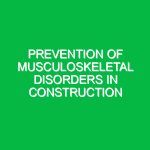Radiation safety is a critical aspect of health, safety, and environment (HSE) protocols, especially in construction sites where radiographic testing is employed. This testing method is vital for assessing the integrity of materials and structures, ensuring that they meet safety standards. However, the use of radiation poses potential risks that require strict safety measures. Understanding radiation safety for construction sites using radiographic testing is essential for protecting workers, the public, and the environment.
Understanding Radiographic Testing in Construction
Radiographic testing (RT) employs radiation to create images of a material’s internal structure. Commonly used in construction, RT helps identify flaws such as cracks, voids, and other discontinuities in welds, metal, and concrete. This non-destructive testing method is invaluable for ensuring structural integrity and compliance with safety standards. However, the use of radiation requires a comprehensive understanding of potential hazards and necessary safety precautions.
Potential Hazards and Risks Associated with Radiation in Construction
Radiation exposure can have serious health implications, making it essential to identify and understand associated risks. The following are significant hazards linked to radiographic testing on construction sites:
1. Ionizing Radiation Exposure
Radiographic testing primarily uses ionizing radiation, which can damage living tissues and increase the risk of cancer over time. Workers may be exposed during the testing process if proper safety protocols are not followed. Exposure can occur through direct contact or secondary radiation from scattered rays.
2. Equipment Hazards
The equipment used in radiographic testing, such as X-ray machines and gamma radiography devices, can pose additional risks. These machines require careful handling and maintenance. Malfunctions or improper use can lead to unintended radiation exposure.
3. Environmental Contamination
Improper disposal of radioactive materials or equipment can lead to environmental contamination. This not only affects the construction site but can also pose risks to surrounding areas and communities. Awareness of disposal regulations is crucial to mitigate this risk.
Safety Precautions for Radiation Safety in Construction
Implementing effective safety measures can significantly reduce the risks associated with radiographic testing. Here are comprehensive safety precautions to consider:
1. Training and Education
All personnel involved in radiographic testing must undergo thorough training. Understanding how radiation works, the associated risks, and safety protocols is essential for minimizing exposure. Regular refresher courses should also be mandated to keep knowledge up-to-date.
2. Use of Personal Protective Equipment (PPE)
Appropriate PPE is vital for workers involved in radiographic testing. This includes lead aprons, gloves, and protective eyewear. These items help shield workers from radiation exposure, particularly during testing operations.
3. Establishing Controlled Areas
Designate specific areas for radiographic testing. These controlled zones should be clearly marked with caution signs, and access should be restricted to authorized personnel only. Effective barriers should be in place to prevent unauthorized entry during testing.
4. Monitoring Radiation Levels
Regular monitoring of radiation levels in and around the testing site is crucial. Use dosimeters and other monitoring devices to ensure that radiation exposure remains within safe limits. Immediate action should be taken if levels exceed established safety thresholds.
5. Implementing Safe Operating Procedures
Establish and follow strict operating procedures for radiographic testing. This includes protocols for setting up equipment, conducting tests, and safely storing radioactive sources. All workers should be familiar with these procedures to ensure compliance and safety.
Best Practices for Radiation Safety on Construction Sites
In addition to safety precautions, certain best practices can enhance radiation safety on construction sites:
1. Regular Equipment Maintenance
Ensure that all radiographic testing equipment is regularly inspected and maintained. This reduces the likelihood of malfunctions that can lead to increased radiation exposure. Keep detailed records of inspections and maintenance activities.
2. Emergency Response Plans
Develop and implement emergency response plans for incidents involving radiation exposure. These plans should outline steps to take in case of accidental exposure, equipment failure, or environmental contamination. Regular drills can help prepare workers for potential emergencies.
3. Communication and Coordination
Effective communication among team members is essential. Ensure that all workers are aware of when and where testing will occur. Coordination with safety officers and regulatory bodies can also facilitate compliance with safety standards.
4. Continuous Improvement
Encourage a culture of continuous improvement regarding radiation safety. Regularly review and update safety protocols based on new research, technology, and feedback from workers. This will help keep safety measures relevant and effective.
Regulations and Standards Governing Radiation Safety
Compliance with regulations is essential for maintaining radiation safety in construction. Various organizations set standards that govern the use of radiation in testing:
1. The Nuclear Regulatory Commission (NRC)
In the United States, the NRC regulates the use of radioactive materials and ensures that safety standards are met. Organizations must be licensed to use radioactive sources for radiographic testing, and they must adhere to strict guidelines to protect workers and the public.
2. Occupational Safety and Health Administration (OSHA)
OSHA sets forth regulations to ensure safe working conditions. This includes standards related to ionizing radiation exposure. Employers must provide adequate training, PPE, and monitoring to comply with OSHA guidelines.
3. American National Standards Institute (ANSI)
ANSI provides standards for the use of radiographic testing in construction. These standards outline best practices, equipment specifications, and safety measures to ensure the safe use of radiation in construction settings.
Conclusion
Radiation safety for construction sites using radiographic testing is a critical consideration in ensuring the health and safety of workers and the public. By understanding potential hazards, implementing strict safety precautions, and complying with relevant regulations, construction companies can minimize risks associated with radiation exposure. Continuous training, monitoring, and a commitment to safety can foster a culture of safety that protects everyone involved in the construction process.


